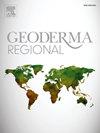The influence of rice husk biochar, compost, and their mixture on maize yields and soil organic carbon content in southern Togo
IF 3.3
2区 农林科学
Q2 SOIL SCIENCE
引用次数: 0
Abstract
Soil fertility decline is the basis of crop yield reduction, especially in sub-Saharan Africa where ensuring food security is one of the greatest challenges. Biochar application could be an option to alleviate this decline, also improving soil organic carbon content (SOC) which is a major goal for resilient agricultural systems under changing climate. This study aimed to understand the effect of biochar applied alone or in combination with compost and mineral fertilizers in synergistic way on SOC and maize productivity. From 2022 to 2024, a two-year field experiment over three growing seasons was conducted in a coastal agroecological zone of southern Togo. The experimental design was arranged in a split-split plot design with three factors: (1) Application of compost (no compost = C0 and 10 t ha−1 = C1), (2) Application of mineral fertilizer (no mineral fertilizer = F0 and half of the recommended rate in the country = F1), (3) Application rates of biochar (0 t ha−1 = B0, 10 t ha−1 = B10, and 20 t ha−1 = B20). A linear mixed-effects model was applied for statistical data analysis. A correlation analysis between, on the one hand, maize yield and yield components and SOC and total nitrogen, on the other hand, was carried out for the second and third growing seasons to understand the interrelation between maize yield and soil properties. The application of 20 t ha−1 of biochar (B20) significantly increased SOC concentration by 2.20 g kg−1. Meanwhile, B10 and C1 did not significantly influence SOC. The effect on soil total nitrogen from different treatments was not significant. Grain yield increased significantly with biochar application at a rate of 20 t ha−1 during the second season, while the positive effect was marginal in the third growing season. The mineral fertilizers showed a significant effect for all three seasons thanks to their immediate response. Our study concluded that applying biochar at a rate of 20 t ha−1, with re-application after one year, can significantly enhance maize yield. This approach may also contribute to mitigating the impact of climate change on agriculture. Biochar can be crucial in building the resilience of maize production to effectively address the decline in soil quality. Although biochar alone in a reasonable rate improved soil carbon and yield in later seasons, its combination with compost and mineral fertilizers did not lead to significant interactive effects under the conditions of this study, suggesting that further research is needed to assess the context-dependent benefits of integrated soil amendments.
稻壳生物炭、堆肥及其混合物对多哥南部玉米产量和土壤有机碳含量的影响
土壤肥力下降是作物减产的基础,特别是在撒哈拉以南非洲,确保粮食安全是最大的挑战之一。生物炭的应用可能是缓解这种下降的一种选择,也可以提高土壤有机碳含量(SOC),这是气候变化下弹性农业系统的主要目标。本研究旨在了解生物炭单独施用或与堆肥和矿质肥料协同施用对土壤有机碳和玉米生产力的影响。从2022年到2024年,在多哥南部沿海农业生态区进行了为期两年的三个生长季节的田间试验。试验设计采用分畦式设计,设3个因素:(1)施用堆肥(不施用堆肥= C0, 10 t ha−1 = C1),(2)施用矿肥(不施用矿肥= F0,全国推荐用量的一半= F1),(3)施用生物炭(0 t ha−1 = B0, 10 t ha−1 = B10, 20 t ha−1 = B20)。采用线性混合效应模型对统计数据进行分析。通过玉米产量、产量组分与有机碳、全氮的相关性分析,了解第二、第三生长季玉米产量与土壤性质的相互关系。施用生物炭(B20)可显著提高土壤有机碳浓度2.20 g kg−1。B10和C1对有机碳无显著影响。不同处理对土壤全氮的影响不显著。第二季施用20 t ha - 1生物炭可显著提高产量,第三季增产效果不明显。由于反应迅速,矿质肥料在三个季节都表现出显著的效果。本研究表明,以20 tha - 1的速率施用生物炭,1年后再次施用可显著提高玉米产量。这种方法也可能有助于减轻气候变化对农业的影响。生物炭对于建立玉米生产的恢复力以有效应对土壤质量下降至关重要。虽然生物炭单独以合理的速率提高了土壤碳和后期产量,但在本研究条件下,生物炭与堆肥和矿质肥料的组合并没有产生显著的交互效应,这表明需要进一步研究来评估综合土壤改良剂的环境依赖效益。
本文章由计算机程序翻译,如有差异,请以英文原文为准。
求助全文
约1分钟内获得全文
求助全文
来源期刊

Geoderma Regional
Agricultural and Biological Sciences-Soil Science
CiteScore
6.10
自引率
7.30%
发文量
122
审稿时长
76 days
期刊介绍:
Global issues require studies and solutions on national and regional levels. Geoderma Regional focuses on studies that increase understanding and advance our scientific knowledge of soils in all regions of the world. The journal embraces every aspect of soil science and welcomes reviews of regional progress.
 求助内容:
求助内容: 应助结果提醒方式:
应助结果提醒方式:


